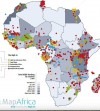Implementing the recommendations of the African Union's Agenda 2063, lowering the fertility rate and reducing conflict could significantly boost economic prosperity and social well-being on the continent in the coming decades.
In the scenario of maintaining the current growth trajectory, the cumulative GDP of African countries should amount to about 8.7 trillion dollars in 2043, against 3.1 trillion dollars in 2019, according to a report published in September 2022 by the South African think tank Institute for Security Studies (ISS Africa).
Entitled “The Africa of Tomorrow – Pathways to Prosperity”, the report states that a full implementation of the recommendations set out in the African Union (AU) Agenda 2063 could however catapult the continent’s GDP to 15 200 billion dollars in 2043. Instead of representing 5% of the world economy in 2043, the African economy would thus represent nearly 9%.
Developed by Jakkie Cilliers, founder of the Institute for Security Studies, the foresight report attempts to predict what Africa could look like by 2043 based on the one hand on the scenario of maintaining current trajectories and on the other hand on the scenario of an implementation of reforms in various fields.
The study points out that a reduction in conflicts on the continent, in line with the AU’s “Silencing the Guns in Africa” action plan, would allow African countries to spend $123 billion on defense budgets in 2043 against 150 billion in the case of maintaining the current trajectories, which would make it possible to direct additional expenditure towards education, health or even infrastructure.
In addition, improved stability would attract more foreign investment, which will boost economic growth and the size of the economy. If Africa succeeds in silencing the guns, it would indeed add some $468 billion to its GDP by 2043 compared to the business as usual scenario.
For its part, GDP per capita would drop from 7157 in 2043 dollars in the scenario of maintaining the current trajectory to 7423 dollars in the case of a significant reduction in conflicts.
Average life expectancy will reach 72.1 years
The sub-regions that could benefit the most from a significant reduction in conflicts are naturally those that are currently the most unstable, in this case West and Central Africa.
On the other hand, the report expects the extreme poverty rate, defined by the threshold of $1.90 a day to live on, to drop from 49% in 2019 (640 million people out of a total of 1 .3 billion Africans) to 44% (755 million people out of 1.7 billion) in 2030, then to 33% (731 million people out of 2.1 billion) in 2043.
In terms of demographic trends, the continent’s population is expected to increase from 1.3 billion in 2019 to 2.2 billion in 2043, before reaching 3 billion in 2063.
This rapid population growth will not allow Africa to benefit from a demographic dividend over the next two decades, with the exception of a handful of countries: Morocco, Egypt, the Seychelles, the Mauritius and South Africa.
The demographic dividend is defined as the acceleration in economic growth and social well-being that can result from a rapid decline in a country’s fertility and subsequent changes in the age structure of its population, with the increase in the share of the active population (non-dependent) and the decrease in the “dependent” population (the youngest and the oldest).
Given current trends, sub-Saharan Africa will only benefit from a demographic dividend after 2050. But in the scenario of a rapid decline in fertility, the region could reach the demographic dividend from 2043.
The report also indicates that the average life expectancy in Africa is expected to reach 72.1 years in 2043 against 65.8 years in 2019 if the continent maintains its current development trajectories.
In the case of improved access to health care and public water and sanitation services, life expectancy will reach 72.8 years. Lesotho, South Africa, Nigeria, South Sudan and Chad should be the countries that will make the most progress in this area.





























Réagissez à cet article